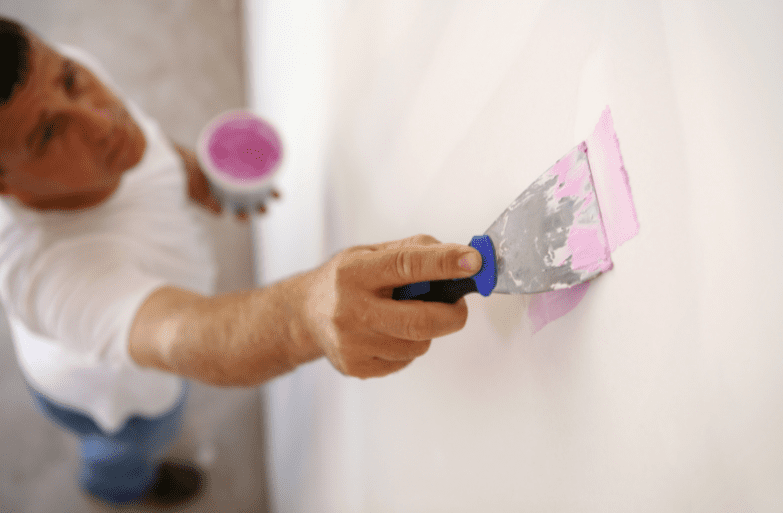Got some drywall that needs TLC? Spackle and joint compound can seem confusing – but knowing the difference means perfect repairs every time.
What is Joint Compound (aka Drywall Mud)?
Your go-to for big drywall jobs! It’s thick, like mud, and mainly made from gypsum.
Best for:
- Covering seams on new drywall
- Major repairs or smoothing of large areas
- Creating a base for paint
Types:
- All-purpose: Versatile, a solid choice for most projects
- Taping: Designed for embedding seam tape
- Topping: Great for a smooth final coat
- Quick-setting: Dries fast, but less forgiving to work with
Pros: Cost-effective for big areas ($10-$15 per gallon, depending on type)
Cons: Often a 24-hour wait to paint, sanding can be tougher
What is Spackle?
The quick-fix superhero! It’s thicker than a joint compound, similar to toothpaste, works on plaster and drywall, and stops shrinking after drying.
-
Best for:
- Nail holes? Spackle’s your friend!
- Small cracks, dents, or minor imperfections
- Patching drywall, plaster, even wood
-
Types:
- Lightweight: Super easy, but for tiny repairs only
- Standard/All-purpose: A bit sturdier
- Vinyl & Acrylic: Bathroom superheroes (resist moisture!)
- Epoxy: The wood filler pro
-
Pros: Dries lightning-fast (often 30 minutes!), super easy to use
-
Cons: Pricier for tiny amounts, sometimes less durable long-term
When to Choose Which
- Size is Key: Thumb-sized hole? Spackle. Covering a wall? Joint compound.
- Durability: Spackle can be less sturdy in high-traffic spots. If in doubt, go joint compound!
Project Examples

Spackle: Your Quick-Fix Friend
Patching Like a Pro: Project Examples
Fixing a Nail Hole with Spackle
- Prep: Gently remove flaky paint/drywall and sand edges lightly if needed.
- Apply: Scoop a bit of spackle (DAP Fast N’ Final is great for this) onto a putty knife. Overfill the hole slightly. Smooth it out.
- Dry & Sand: Follow your spackle’s instructions. Fine-grit sandpaper makes it flush with the wall.
- Pro Tip: Tiny hole? Your fingertip is the perfect spackle applicator!
-
Patching a small dent from moving furniture:
- Cleaning up: Ensure the area is free of dust or debris. If it’s a deeper dent, very lightly sand any rough or pointed edges.
- Choosing the right spackle: For a dent bigger than a nail hole, standard or all-purpose spackle might be sturdier than the lightweight kind.
- Building it up: Apply the spackle in thin layers, letting each layer dry fully before adding more. This prevents slumping and cracking.
- Final touch: Sand until completely smooth and even with the surrounding wall. Wipe away any dust before painting.
This technique also works great for restoring old, uneven plaster walls.
Extra Tips:
- Always read instructions: Different spackle brands may have slight variations in drying time and sanding recommendations.
- Painting over spackle: Using a primer helps ensure even paint coverage and prevent a ‘flashing’ effect where the patched area looks slightly different.
Joint Compound: The Backbone of Smooth Walls

-
Installing new drywall:
- Taping the seams: After drywall sheets are hung, apply drywall tape along the seams. Embed the tape into a thin layer of joint compound, smoothing it out with a drywall knife.
- Multiple coats: Once the tape is dry, apply several wider coats of joint compound, feathering the edges outward to blend it seamlessly into the existing drywall. Let each coat dry and sand before applying the next.
- Choosing compound: All-purpose compound is versatile, but taping compound is specifically designed for embedding the tape. Topping compound is best for the final smooth layer.
-
Skimming a rough wall
- Assess the damage: Is the wall just slightly uneven, or are there major cracks or divots? Large repairs might need patching with spackle or new drywall first.
- Clean & prep: Remove loose paint, dirt, or wallpaper. A good surface is key for joint compound to adhere properly.
- Thin layers are key: Apply the joint compound in several thin coats rather than one thick layer. This reduces cracking and drying time.
- The right tools: Use wider drywall knives (10-12 inches) for skimming to help create a smoother surface.
Additional Considerations:
- Quick-setting vs. regular compound: Quick-setting compound dries faster but can be harder to work within a beginner. Consider your experience level.
- Sanding: It’s messy but crucial! Use a sanding pole and dust mask for large areas. A damp sponge can help minimize dust for final sanding.
- Priming is a must: Joint compound is porous. Primer creates a uniform surface for your paint, preventing uneven absorption and a patchy look.
Tips & Tricks for Flawless Repairs
-
Budget Wise: A big bucket of joint compound is tempting, but it might go bad before you use it all. Spackle’s smaller containers are often a better deal for tiny fixes.
-
Work Smarter, Not Harder: Deep Hole? Both spackle and joint compound work best in thin coats with drying in between. It prevents cracking and makes your life easier!
- How to smooth spackle before it dries: Get it Glassy-Smooth: Need that spackle patch to disappear completely? Here’s a trick: Once it starts setting up (check your spackle’s instructions for timing), lightly mist the surface with water from a spray bottle. Then, gently glide a clean putty knife over it. This helps create a perfectly smooth finish before sanding!
-
Smooth Moves:
- Spackle Saver: Need a few more minutes? Tiny bit of water slows drying.
- Less Mess: A damp sanding sponge cuts down joint compound dust.
-
Tools Matter:
- Putty Knives: Get a few sizes. Plastic’s fine for tiny fixes, metal is best for joint compound.
- Sanding Power: Blocks give good pressure. Poles save your arms on big areas!
-
Waste Not, Want Not:
- Spackle: Airtight lid is key. Tiny bit of water revives slightly dried-out spackle
- Joint Compound: Smooth it out, add a layer of water on top before sealing. Stir well next time.
Spackle: The Multitasker
- Woodworker’s Friend: Epoxy spackle fills gouges, then sands beautifully before painting!
- Bathroom Buddy: Vinyl or acrylic spackle won’t get soggy in humid areas.
- Beyond Drywall:
- Outdoor Patches: (Check the label, some exterior spackles exist)
- Tiling Prep: Vinyl spackle can fill a hole before re-tiling in a pinch
- Get Crafty: Spackle adds texture to art projects!
Best spackle for bathroom ceiling repair
Bathroom Repairs? Choose Wisely: Regular spackle can get soggy in a steamy bathroom. Look for vinyl or acrylic spackle for ceilings, shower surrounds, or areas prone to moisture. These are designed to resist humidity and keep your repairs looking fresh year-round.
Can I use Spackle to patch wood furniture?
Furniture Fixer: Scratched table leg? Gouge on your dresser? Epoxy-based spackle is your go-to. Unlike regular spackle, it dries rock-hard and can be sanded, stained, or painted like wood. It is ideal for filling imperfections before refinishing that favorite piece.
Important: Always read your product instructions for the best results!
Further uses
-
…On wood? Yes! But not all spackles are created equal. Choose an epoxy-based spackle specifically designed for wood. It dries hard and can be sanded, making it ideal for filling gouges or imperfections before painting or staining furniture.
-
…In the bathroom? Absolutely, but regular spackle can absorb moisture. For bathrooms, opt for vinyl or acrylic spackle. These are formulated to resist moisture, preventing them from softening or crumbling in humid environments.
-
…On other surfaces? Spackle’s versatility might surprise you!
- Exterior repairs: Some specialized exterior spackles can handle small fixes on siding or concrete. Always check the label.
- Small tile jobs: Need to fill a hole before re-tiling? Vinyl spackle can work in a pinch.
- Creative crafts: Believe it or not, some DIYers even use Spackle to create textured effects on projects!
Important Note: Always check the manufacturer’s instructions for your chosen spackle to ensure it suits your project and surface.


























